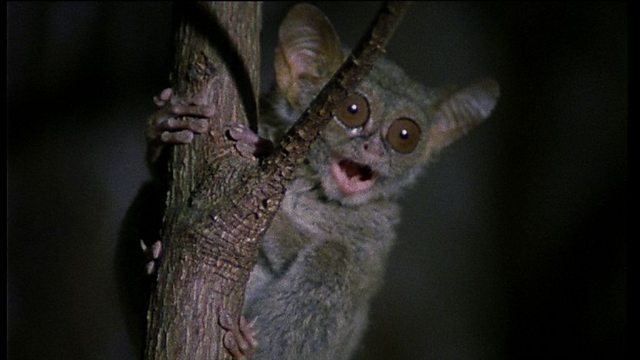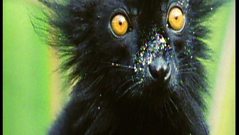
Old big eyes
Tarsiers are nocturnal, but their big eyes signify this wasn't always so.
As trees spread across the globe, so did early primates. Perhaps it's surprising they never ventured out into daylight. Or did they? Charlotte Uhlenbroek is in Indonesia looking for tarsiers who may give us some clues. At nightfall they begin to emerge from their nest. Tarsiers look very much like other early primates, but their eyes are huge - each one weighs more than its brain. It has no problem spotting a gecko. Unlike bushbabies and other night animals, tarsiers do not have eyes that glow in torchlight, and this might tell us something about their past. Maybe they once lived in daylight, have now returned to the dark, and their eyes have become huge simply in order to see. Just before dawn, the tarsiers start squeaking, telling each other it is bedtime. They gather at the communal nest, their calls the equivalent of the hugs and kisses we give our own families when we come home. They won't go to bed until they are sure everyone is safely back at the nesting tree. Since a social life is more typical of daytime animals, this is further evidence that tarsiers ventured into the light. So what forced them back into the dark? It was the competition they faced from a new branch of the primate family - the monkeys and apes who dominated the daylight.
Duration:
This clip is from
Featured in...
![]()
ÃÛÑ¿´«Ã½ Nature
Be captivated, informed and inspired by the world's wildlife.
More clips from FIRST PRIMATES
-
![]()
Arboreal ancestors
Duration: 02:32
-
![]()
Poison bath
Duration: 02:10
-
![]()
Pitched battle
Duration: 03:00
-
![]()
Millipede insecticide
Duration: 03:09
More clips from Cousins
-
![]()
A nose for swamp food—MONKEYS
Duration: 01:32
-
![]()
Food for thought—APES
Duration: 02:14
-
![]()
Free lunch—MONKEYS
Duration: 01:17
-
![]()
Arboreal ancestors—FIRST PRIMATES
Duration: 02:32









